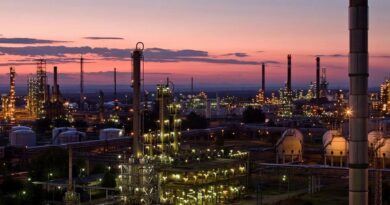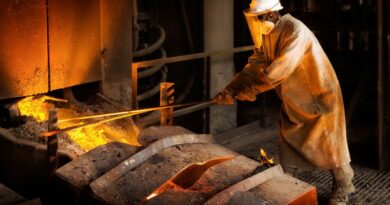Rio Tinto releases second quarter production results
MELBOURNE, Australia- Rio Tinto Chief Executive Jakob Stausholm said: “We built further momentum in our Pilbara iron ore business for the quarter, and now expect to deliver shipments in the upper half of our guidance range for the year. The ramp-up of the Oyu Tolgoi underground mine progressed ahead of plan, and we remain on track to more than triple its copper production by the end of the decade. Production downgrades during the quarter highlight that we still have much more to do elsewhere, as we roll out the Safe Production System to create stability and achieve excellence across our global portfolio.
“We continued to take disciplined measures to grow in the materials the world needs for the energy transition, with investments to expand our low carbon aluminium production and increase our underground copper production at Kennecott.
“We are taking practical steps and making investments to decarbonise, being the first to convert an open pit mine to renewable diesel at our Boron operations, signing a memorandum of understanding with Baowu to explore decarbonisation of the steel value chain and delivering first production from our ground-breaking BlueSmelting demonstration plant at Sorel-Tracy in Quebec in July.”
| Production* | Quarter 2 2023 | vs Q2 2022 | vs Q1 2023 | H1 2023 | vs HY 2022 | ||||
| Pilbara iron ore shipments (100% basis) (Mt) | 79.1 | -1% | -4% | 161.7 | +7% | ||||
| Pilbara iron ore production (100% basis) (Mt) | 81.3 | +3% | +2% | 160.5 | +7% | ||||
| Bauxite (Mt) | 13.5 | -5% | +12% | 25.6 | -8% | ||||
| Aluminium (kt) | 814 | +11% | +4% | 1,598 | +9% | ||||
| Mined Copper (consolidated basis) (kt) | 145 | -1% | 0% | 290 | -1% | ||||
| Titanium dioxide slag (kt) | 303 | +4% | +6% | 589 | +4% | ||||
| IOC** iron ore pellets & concentrate (Mt) | 2.1 | -21% | -18% | 4.6 | -8% | ||||
| *Rio Tinto share unless otherwise stated | |||||||||
| **Iron Ore Company of Canada | |||||||||
Q2 2023 operational highlights and other key announcements
- Our all-injury frequency rate of 0.36 was a small increase from the second quarter of 2022 (0.35), and from the prior quarter (0.35). Investigations are underway following significant process safety incidents. There were two incidents at our Rio Tinto Iron and Titanium (RTIT) Sorel-Tracy complex which did not result in injuries. The Kennecott operation experienced an escape of furnace gas during the maintenance shut, where all treated people have been cleared. We are heightening our focus on managing these risks and continue to prioritise the safety, health and wellbeing of our workforce, and communities where we operate.
- Pilbara operations produced 81.3 million tonnes (100% basis) in the second quarter, 3% higher than the second quarter of 2022 as Gudai-Darri achieved sustained nameplate capacity during the period. Shipments were 79.1 million tonnes (100% basis), 1% lower than the corresponding period of 2022, reflecting the impact of planned major maintenance at the Dampier port and a train derailment. With continued operational improvements across the Pilbara system, and the implementation of the Safe Production System, full year shipments are now expected to be in the upper half of the original 320 to 335 million tonne range.
- Bauxite production of 13.5 million tonnes was 5% lower than the second quarter of 2022 as our Weipa operations were impacted by the higher-than-average first quarter rainfall, which continued to reduce pit access and led to longer haul distances. Production was further affected by equipment downtime at both Weipa and Gove. As a result, our bauxite full year production is expected to be at the lower end of our 54 to 57 million tonne range, as we implement plans to recover lost production at both operations through the remainder of the year.
- Aluminium production of 0.8 million tonnes was 11% higher than the second quarter of 2022 as we benefited from the continued ramp-up of the Kitimat smelter. Recovery at the Boyne and Kitimat smelters is progressing to plan with full ramp-up expected to be completed later in the year. All our other smelters continued to demonstrate stable performance during the quarter.
- On 12 June, we announced an investment of $1.1 billion to expand our AP60 aluminium smelter equipped with low-carbon technology at Complexe Jonquière in Canada. The total investment includes up to $113 million of financial support from the Quebec government. This expansion will coincide with the gradual closure of potrooms at the Arvida smelter on the same site. While at our Alma smelter in Lac-Saint-Jean, Quebec, we commenced construction to increase our capacity to cast low-carbon, high-value aluminium billets.
- Mined copper production of 145 thousand tonnes (on a consolidated basis), was 1% lower than the second quarter of 2022. We benefited from the continued ramp-up of the high grade underground mine at Oyu Tolgoi. However, this benefit was more than offset by the continued operation of Kennecott’s concentrator at reduced rates, as we recovered from a conveyor failure in March 2023, and unplanned maintenance, and lower crusher and conveyor availability, at Escondida.
- Refined copper guidance has been reduced to 160 to 190 thousand tonnes (previously 180 to 210 thousand tonnes) and our copper C1 unit cost guidance has been raised to 180 to 200 US cents/lb (from 160 to 180 US cents/lb) as completion of the rebuild of the Kennecott smelter is now expected in September 2023 (previously August 2023). The extension of the rebuild is due to the addition of a full rebuild of the flash converting furnace to the scope, which is expected to further improve asset stability and process safety management.
- On 20 June, we announced $498 million of funding to deliver underground development and infrastructure for an area known as the North Rim Skarn1 (NRS) at Kennecott. Production from the NRS will commence in 2024 and is expected to ramp up over two years, to deliver ~250 thousand tonnes of additional mined copper over the next 10 years2 alongside open cut operations.
- Titanium dioxide slag production of 303 thousand tonnes was 4% higher than the second quarter of 2022, due to improved operational performance at our smelters. Notwithstanding, our RTIT Quebec Operations experienced two incidents in separate furnaces in June and July which we are investigating. Given these investigations and weaker market conditions, our full year production is expected to be at the lower end of the 1.1 to 1.4 million tonne range.
- IOC production was 21% lower than the second quarter of 2022 as we lost ~3.5 weeks of production in June, primarily due to wildfires in Northern Quebec, together with a slightly extended shutdown. Operations have resumed, however our full year production guidance has been reduced to 10.0 to 11.0 million tonnes (previously 10.5 to 11.5 million tonnes), and remains subject to further disruption from fire conditions.
- At our Rincon lithium project in Argentina, our $140 million estimate and schedule to develop the starter plant remains under review in response to cost escalation.
- In the second quarter, we commenced deployment of the Safe Production System at a further two sites, taking the total to 20 sites. The Safe Production System focuses on continuously improving safety, strengthening employee engagement and sustainably lifting operational performance across our global portfolio. While we still have a lot to do to see sustainable improvement, site deployments are rolling out according to plan and we expect to be at the upper end of our range of four to eight new sites in 2023.
- On 13 June, we announced that Ivan Vella, Chief Executive, Aluminium, has accepted a new position outside of Rio Tinto and will leave in December 2023. He will continue to lead Aluminium while a robust process to identify his successor is undertaken but has stepped down from the Group’s executive committee.
- We saw a cash outflow from an increase in working capital of circa $0.9 billion in the first half of 2023, reflecting a build in blasted and mine stocks in the Pilbara to support overall system health, and higher spares and stores (including seasonality due to the Diavik winter road). Payables were also lower due to the timing of spend, and normal volatility in amounts due to JV partners and employees. Operating cash flow was also impacted by lower dividends from Escondida during the first half ($0.3 billion in H1 2023; $0.6 billion in H1 2022).




